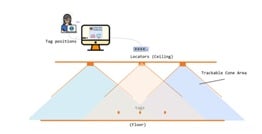Assets are valuable which is why their location is monitored closely by many organizations. In fact, Location Finding Systems (LFS) are used to enhance safety, productivity, and efficiency in sectors such as retail, logistics, healthcare, smart buildings and more. Location Finding Systems are typically based upon wireless ‘tags’ that can be applied to almost any physical object, person, and many applications.
Some use case examples include tracking packages through a logistics process or key materials in a manufacturing environment, monitoring the location of high-value instruments in a laboratory or hospital and lastly, knowing when a person has entered a restricted area. For example, in a factory there may be danger in certain areas. LFS can help retailers hone their layouts by tracking and analyzing the way customers move around a store or using self-checkout.
Wireless Technology for LFS
LFS must be based upon wireless technology but several technologies that are available have advantages and disadvantages. In choosing a technology, designers are faced with a trade-off between coverage and power consumption – particularly important as the wireless tags are generally battery powered.
RFID can be used for location, but its primary use is to verify the identity of an asset (e.g. color and style of an item of clothing) at a specific checkpoint. If high security is a concern, then ultrawideband (UWB) is often preferred. However, the high level of processing drives cost and power consumption up.
5G benefits from a global network of coverage, allowing assets to be tracked over significant distances. However, it does consume significant energy, so its applications are relatively limited in this space.
Bluetooth® is a proven technology that has billions of devices deployed globally. Over its lifetime, the technology has been honed to reduce power consumption and the high production volume keeps costs low. In fact, Bluetooth Low Energy (Bluetooth LE) is now one of the most preferred asset-tracking technologies.
Bluetooth-based LFS – Overview and Design Criteria
Bluetooth-based LFS systems are commonly used within buildings such as a warehouse, factory, healthcare facility or retail outlet. Within any system, there are usually three main elements:
- The tag that is affixed to the asset
- A number of locators
- The localization engine.
When designing an LFS, designers have to juggle resolution, latency and battery life, tailoring the trade-offs to meet the system requirements with regard to accuracy, efficiency and performance.
The largest impact on resolution is from the number of sensors / locators – more will enable more precise measurement of location.
Latency refers to how quickly a tag / asset can be found, and this relates to how often a signal is transmitted. Transmitting more frequently will reduce latency but increase drain on the battery.
The battery life is also affected by the output power and the duration of each transmission, as well as whether the tag is able to take advantage of any low-power ‘sleep’ mode.
If an asset is fast moving then lower latency (more transmissions) is required to get an accurate position fix. However, this comes at the cost of battery life. More sophisticated systems may incorporate an accelerometer into the tag so that transmission frequency can be increased only when the asset is moving. This gives the best of both worlds, accurate positioning and reasonable battery usage.
Flexibility in Design
As each application is different, and technology is evolving so rapidly, flexibility to trade off one parameter against another, and to adjust as and when needs change, is essential to LFS design. onsemi has supported this need for flexibility through the development of a design platform with industry partners.
The collaboration, integrates onsemi’s award-winning RSL15 with CoreHW antenna modules and the Unikie Localization
The RSL15 Bluetooth 5.2 wireless MCU is designed for connected smart devices and is based upon the ultra-low power ARM® Cortex®-M33 processor. According to EEMBC benchmarks, the RSL15 delivers the lowest power Bluetooth performance. This, along with its compact size make it ideal for edge applications such as location tags.
To learn more, read our technical white paper entitled “Designing Power-Efficient Wireless Location Finding Systems” that covers the technologies involved, theory of operation, and critical design factors for localization.

